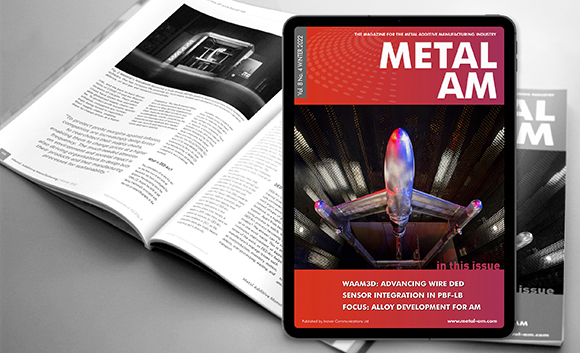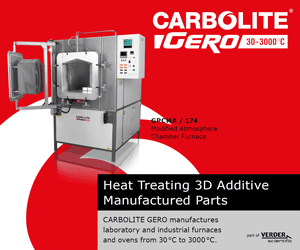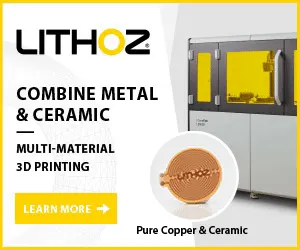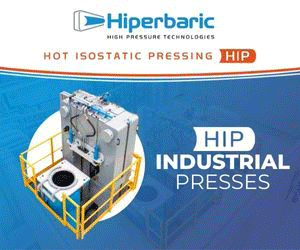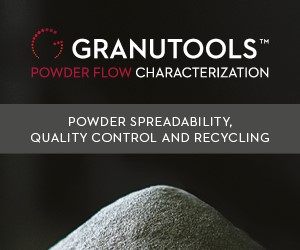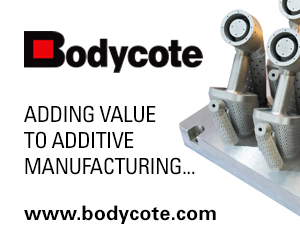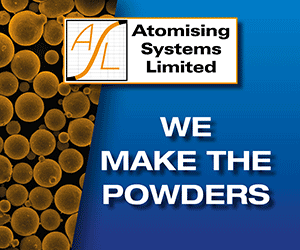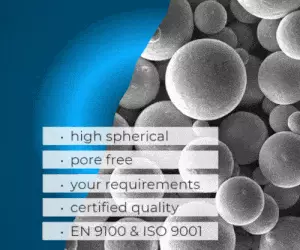Metal Additive Manufacturing, Vol. 8 No. 4 Winter 2022
Prefer a PDF download? Click here
In addition to the latest industry news, this 172-page issue of Metal Additive Manufacturing magazine includes the following exclusive features:
What happens when you take the powder out of AM? Charting the rise of wire-based DED with WAAM3D
While most people associate the advantages of AM with small- to medium-sized, complex parts, wire-based Directed Energy Deposition (DED) makes it possible to achieve geometric complexity on a huge scale. Although the adoption rate for wire-based DED does not come close to that of the more widely known metal AM processes, this unique technology has advanced dramatically over recent years, and promises major advantages in a volatile global manufacturing landscape. Dr Filomeno Martina, CEO and co-founder of WAAM3D, explains more.
| Get PDF | | | Read online |
Smart sensor-integrated parts by AM: A look at a novel possibility with industrial applications
Additive Manufacturing processes offer a high degree of design freedom. The Laser Beam Powder Bed Fusion of metals (PBF-LB/M), in particular, has established itself for series applications of complex-shaped parts in numerous industries.
In this article, Prof Dr-Ing Christian Seidel considers the next major step in PBF-LB, which could offer designers unknown potential: the production of sensor-integrated AM parts. Methods and solutions for the manufacturing of sensor-integrated AM parts are presented and industry-relevant case studies showcased, illustrating the potential offered by sensor-integrated ‘smart parts.’
| Get PDF | | | Read online |
Tailored materials for AM: How a ‘powder kit’ can achieve greater material diversity with fewer resources in PBF-LB
The use of metal AM is ramping up, and so, as a result, is the demand for metal powders. However, the variety of materials available remains relatively small. This is due, among other things, to the exacting requirements for the powders used, and the method of production. In addition, the production of smaller quantities of powder can be uneconomical.
In a project funded by the AiF, the IWM at Germany’s RWTH Aachen University and Fraunhofer IFAM have developed a sustainable ‘powder kit’ for the individual and robust production of metal powder mixtures with subsequent alloying during PBF-LB processing. The partners share their progress.
| Get PDF | | | Read online |
QuesTek’s ICMD: Faster, cheaper, and better alloy development for Additive Manufacturing
Alloy development has evolved dramatically throughout history, from what was a game of ‘trial and error’ to a systematic approach driven by Design of Experiments and specialist software. Now, the adoption of Integrated Computational Materials Engineering (ICME) is once again changing the way new materials are developed and deployed in today’s advanced manufacturing technologies.
QuesTek’s Keith Fritz, Director of Solutions Architecture, details how the company’s ICMD® platform is enabling faster, cheaper and more successful development of new alloys for metal Additive Manufacturing, as well as the build parameters to process them.
| Get PDF | | | Read online |
NanoAL: Alloy development on an open parameter PBF-LB machine, from installation through to Rapid Alloy Screening
When NanoAL, LLC, a company with a decade of aluminium alloy development experience, decided to speed up its development of alloys for AM, it turned to SLM Solutions’ SLM®125 PBF-LB machine. As NanoAL’s Matthew Simmers explains, the company needed a workhorse machine that fulfilled a number of requirements, from open parameters and material flexibility to specifications and build quality that closely mirrored larger, production-focused machines.
This article explores machine choice, installation, and operation in supporting NanoAL’s Rapid Alloy Screening (RAS) process.
| Get PDF | | | Read online |
Using the Six Sigma method to optimise metal powder spreading in PBF-LB
In Laser Beam Powder Bed Fusion (PBF-LB), powder is applied to the build platform by a recoater unit performing a horizontal movement. Though not often the focus of research, the quality of powder layers has a significant influence on the quality of the final part, making the powder application process highly relevant to PBF-LB’s productivity and reliability.
A collaborative project between the Chair of Hybrid Additive Manufacturing (HAM) at the Ruhr University Bochum and the consulting firm MTS Consulting Partner has shown how the Six Sigma method can be used to improve the process of metal powder application in the PBF-LB process.
| Get PDF | | | Read online |
Insights from R&D to part production: How CT analysis can advance metal Binder Jetting
In the race to optimise AM technologies for the creation of both breakthrough designs and direct part replacements, it is more necessary than ever that companies have access to the deep insights and data needed to advance part designs and processing at every phase of product development. Thanks to its ability to provide these insights non-destructively and in great detail, CT analysis provides an invaluable tool for the advancement of AM processes and their adoption.
Philip Sperling, Product Manager AM at Volume Graphics, explains how CT analysis can advance the development and adoption of metal Binder Jetting (BJT).
| Get PDF | | | Read online |
Corrosion and wear resistence of materials processed by beam-based AM technologies
A technical session at the World PM2022 Congress & Exhibition, organised by the European Powder Metallurgy Association (EPMA) and held in Lyon, France, October 9-13, 2022, focused on the corrosion and wear resistance of materials processed using beam-based Additive Manufacturing. This session comprised three papers which looked at ways to improve these properties – both particular pain points for AM’s wider adoption – by way of chemical-mechanical surface polishing, adjusted laser power, and the development of new, wear-resistant alloys for AM. Dr David Whittaker reviews the presented papers.
| Get PDF | | | Read online |



